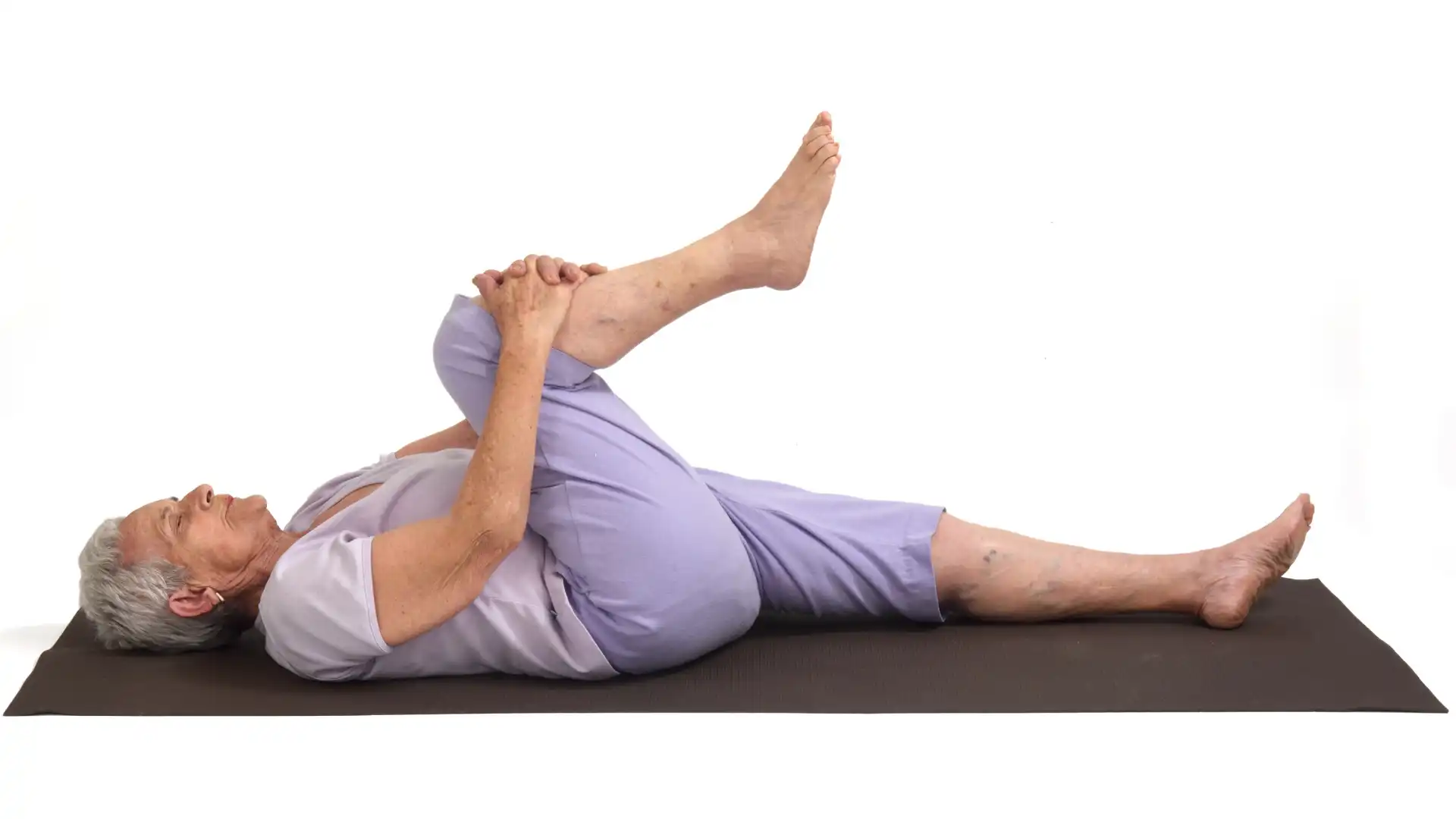VIDEO! Yoga Healthy Aging: 3 Yoga Poses for Hip Arthritis

As many of you may know from personal experience or from observing others as they age, the most common age-related problem for the hips is the development of arthritis in one or both hip joints. Before discussing this condition—and how yoga can help—let’s start by taking a look at the hip joint so you have a deeper understanding of how the joint works and how arthritis affects this very important joint.
How the Hip Joint Works
The hip joint is a “synovial joint,” a type of joint that connects two bones together with a joint capsule, a sock-like sleeve of connective tissue that holds the two bones relatively close together. In the case of your hip joint, this means that your pelvic bone and your thighbone (femur) connect to each other through the hip joint capsule.
The inner lining of this capsule is lined with the synovial membrane, a specialized tissue that secretes a lubricating liquid, not unlike the oil in your car engine, to allow the bones to move over each other more smoothly. In addition, the ends of the bones themselves are coated with a layer of cartilage—also a kind of connective tissue—that acts as a tough barrier for shock absorption, and is smooth and slick, so the bones again can glide over each other more easily.
Finally, the inner surface of the acetabulum, the hollowed out part of the pelvic bone that the head of the thighbone fits into, has an additional cushion of cartilage lining called the labrum. The labrum provides a better fit for the two bones as well as additional shock absorption.
How Arthritis Affects the Hip
Now that you have some idea of how the hip joint is constructed, we can talk a bit about how arthritis can develop there. As with arthritis anywhere in the body, there are two basic types: osteoarthritis and rheumatoid arthritis. Osteoarthritis (OA), which is the most common type, is the age-related, wear-and-tear type of arthritis.
In this, the cartilage covering the ends of the bones is worn away gradually, exposing sensitive raw bone, which, when rubbing against another raw bone, leads to inflammation inside the synovial joint described above. This results in swelling, stiffness, tightness, decreased movement, and pain. Osteoarthritis can be caused by repeated movements over a long time or some old trauma, infection, or injury to the joint.
Rheumatoid arthritis, on the other hand, is an autoimmune disease that is not age-related. In an autoimmune disease, your body mistakes part of itself—in this case, the joint lining—as a foreign invader and mounts an inflammatory response to fight it off. And this inflammatory response damages the cartilage at the ends of the bones. We won’t be addressing this type of arthritis in this article.
Do you teach yoga to older beginners? Join us for a free 3-part webinar series on how to build your yoga business, featuring a presentation by Dr. Baxter Bell
So how do you know whether you have arthritis of the hip joint? As we mentioned above, osteoarthritis in a joint causes swelling, stiffness, tightness, decreased movement, and pain. And typically people with osteoarthritis of the hip will notice that stiffness and reduced range of motion in their hip joint. They may also experience a “catching” or “clicking” in the joint. Feeling pain in the hip, including in the groin, the side of the hip, the back of the hip (the buttock) and even in the knee, is also common. This pain often worsens after climbing a lot of stairs, standing for long periods, walking long distances, or possibly after doing a vigorous yoga practice. However, if you are having any of these symptoms, we recommend that you see your physician for a thorough examination to get a final diagnosis.
If you do receive a diagnosis of hip osteoarthritis, your doctor will typically make the following two recommendations: resting and stopping any activities that could be straining your hip joint or the area around it. The doctor may also recommend that you see a physical therapist for exercises that will improve your hip joint’s range of motion and strengthen muscles that support it.
Yoga and Arthritis in the Hip Joint
This is also a good time to take a look at what you are already doing in your yoga practice to see if any of the poses or vinyasa practices you do now could be contributing to your pain and dysfunction. Do you feel pain while doing certain poses, such as in the front leg hip joint in Anjaneyasana (Lunge Pose)? Do you have a flare of pain in your hip after a yoga class or the next morning? If the answer to any of these questions is yes, consider avoiding the offending poses or practices, at least temporarily.
However, this is also a good time to determine how yoga can fit into your healing regimen. And, in fact, it is not uncommon for a person to start yoga in the first place because they have heard it could help their arthritis. In this setting, we recommend that you begin at the beginning, with a gentle practice as your entry into yoga. A one-on-one session would also be a good way to start.
1. Yoga for Arthritis: Dynamic Reclined Hip Stretches
For those with persistent pain, we recommend that you start with gentle hamstring and hip stretching, such as Dynamic Reclined Hip Stretches, (see video below) which gently move your hip joint through many of the movements it allows.
2. Yoga for Arthritis: Dynamic Snow Angel Legs
Next, try Dynamic Snow Angel Legs.
-
Start by lying on your back with your legs close together.
-
Inhale and spread your legs wide on the floor, without rolling your thighs in or out.
-
Exhale and return your legs back to center.
3. Yoga for Arthritis: Dynamic Locust Pose (Salabhasana)
Finally, try Dynamic Locust Pose. (see video below)
-
Start by lying on your belly.
-
On your inhalation, as you lift your chest, lift one leg off the floor without bending your knee.
-
On your exhalation, release your chest and the lifted leg back to the floor.
-
Repeat on the other side.
These three yoga poses will give you a better sense of the range of motion of your hips—right and left—as well as movements that cause immediate pain, which will be very useful information as you explore other poses in different positions.
Other Helpful Yoga Poses for Arthritis
In general, keeping your hip joint as mobile as you can and the supporting muscles as strong as possible will help you stay functional and prolong the time before surgery has to be considered (surgery is not inevitable, by the way).
Because you can do many yoga poses without bearing direct weight on your hip joints, including prone or supine poses, seated poses, and inversions, yoga provides many ways for you to work on both joint ranges of motion and strengthening. For example, Supta Padangusthasana (Supine Leg Stretch) with variations, help both mobility and strength. And when full weight on the joint needs to be avoided, you can even do the standing poses in a fairly weight-free manner if you support your pelvis on a chair, including the chair versions of Anjaneyasana (Lunge Pose), Virabhadrasana I and II (Warrior I and II), and Parsvakonasana (Extended Side Angle Pose). I understand that yoga is even being taught in swimming pool settings, where weightlessness is beneficial for arthritic hip joints. Sounds potentially helpful, but I’d skip the inversions class!
As always, using yoga pain management techniques, such as breath work and meditation can help you in reducing the pain you are experiencing.
When your symptoms are milder, you can try adding vinyasas, such as Sun and Moon Salutations, to your home yoga practice. Do these practices slowly, mindfully, and with the idea of soft foot landings.
Your yoga practice can diminish your pain, improve your mobility, and delay any invasive treatments, so you’ll be getting your money’s worth! And the equanimity that is a result of a balanced yoga practice can hopefully support you through any difficult decisions you may need to make about your hip.
Do you teach yoga to older beginners? Join us for a free 3-part webinar series on how to build your yoga business, featuring a presentation by Dr. Baxter Bell
This article originally appeared on Yoga for Healthy Aging. Reprinted with permission.
 Baxter Bell, MD, is a yoga teacher and educator, physician and medical acupuncturist. These days he focuses on teaching yoga full-time, both to ordinary students of all ages and physical conditions and to the next generation of yoga teachers, to whom he teaches anatomy and yoga therapy along with his accessible, skillful style of yoga. Baxter brings a unique perspective to his teaching, combining his understanding of anatomy and medicine with his skill at instructing people from all walks of life and all levels of ability. Baxter is the co-founder and writer for the popular Yoga for Healthy Aging blog, where he shares his knowledge of medical conditions, anatomy, and yoga with practitioners and teachers across the world. In addition to being a frequent presenter at Yoga Journal Alive events and yoga conferences such as IAYT’s SYTAR, he is often quoted as an expert on yoga and health by major national news outlets such as The Washington Post and Wall Street Journal. To learn more, visit www.baxterbell.com, www.yogaforhealthyaging.blogspot.com, and his YouTube channel Baxter Bell Yoga.
Baxter Bell, MD, is a yoga teacher and educator, physician and medical acupuncturist. These days he focuses on teaching yoga full-time, both to ordinary students of all ages and physical conditions and to the next generation of yoga teachers, to whom he teaches anatomy and yoga therapy along with his accessible, skillful style of yoga. Baxter brings a unique perspective to his teaching, combining his understanding of anatomy and medicine with his skill at instructing people from all walks of life and all levels of ability. Baxter is the co-founder and writer for the popular Yoga for Healthy Aging blog, where he shares his knowledge of medical conditions, anatomy, and yoga with practitioners and teachers across the world. In addition to being a frequent presenter at Yoga Journal Alive events and yoga conferences such as IAYT’s SYTAR, he is often quoted as an expert on yoga and health by major national news outlets such as The Washington Post and Wall Street Journal. To learn more, visit www.baxterbell.com, www.yogaforhealthyaging.blogspot.com, and his YouTube channel Baxter Bell Yoga.
 Nina Zolotow, RYT 500, Editor-in-Chief of the Yoga for Healthy Aging blog, is both a yoga writer and a yoga teacher. She trained to be a yoga teacher at The Yoga Room in Berkeley, California, has studied yoga therapy with Shari Ser and Bonnie Maeda, and is especially influenced by the teachings of Donald Moyer. She also studied extensively with Rodney Yee and is inspired by the teachings of Patricia Walden on yoga for emotional healing. Her special area of expertise is yoga for emotional well-being (including yoga for stress, insomnia, depression, and anxiety) and she teaches workshops and series classes on yoga for emotional well-being, stress management, better sleep, home practice, and cultivating equanimity. Nina is the co-author, with Rodney Yee, of two books on yoga: Yoga: The Poetry of the Body and Moving Toward Balance, both of which are widely available, and is currently writing a book with Baxter Bell on Yoga for Healthy Aging for publication in 2017.
Nina Zolotow, RYT 500, Editor-in-Chief of the Yoga for Healthy Aging blog, is both a yoga writer and a yoga teacher. She trained to be a yoga teacher at The Yoga Room in Berkeley, California, has studied yoga therapy with Shari Ser and Bonnie Maeda, and is especially influenced by the teachings of Donald Moyer. She also studied extensively with Rodney Yee and is inspired by the teachings of Patricia Walden on yoga for emotional healing. Her special area of expertise is yoga for emotional well-being (including yoga for stress, insomnia, depression, and anxiety) and she teaches workshops and series classes on yoga for emotional well-being, stress management, better sleep, home practice, and cultivating equanimity. Nina is the co-author, with Rodney Yee, of two books on yoga: Yoga: The Poetry of the Body and Moving Toward Balance, both of which are widely available, and is currently writing a book with Baxter Bell on Yoga for Healthy Aging for publication in 2017.





